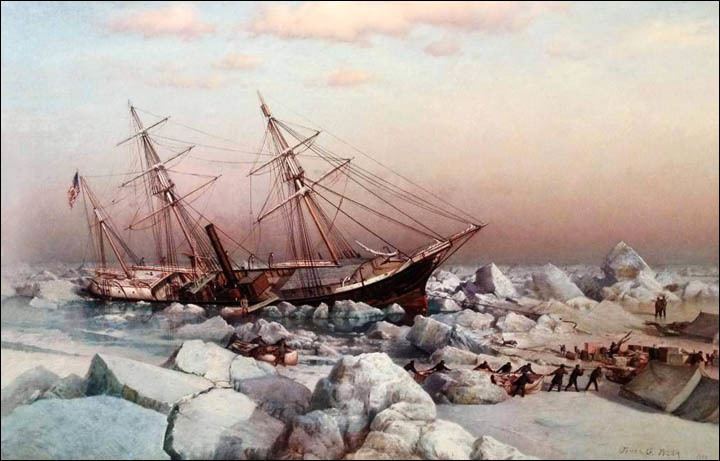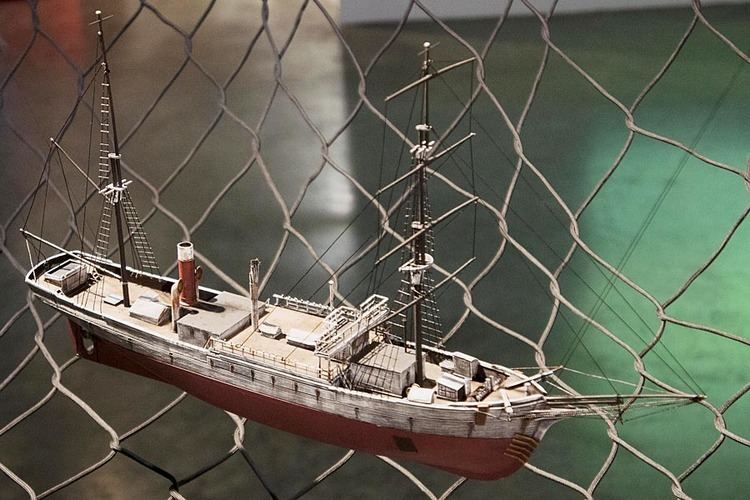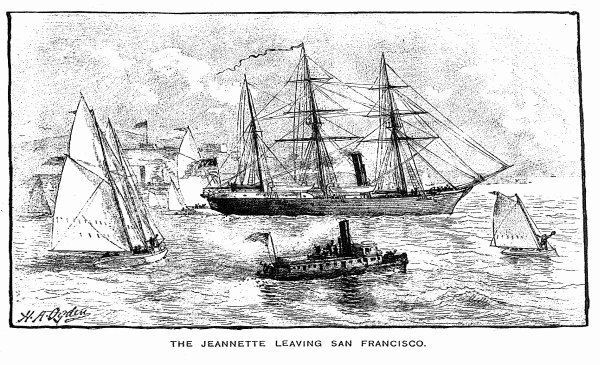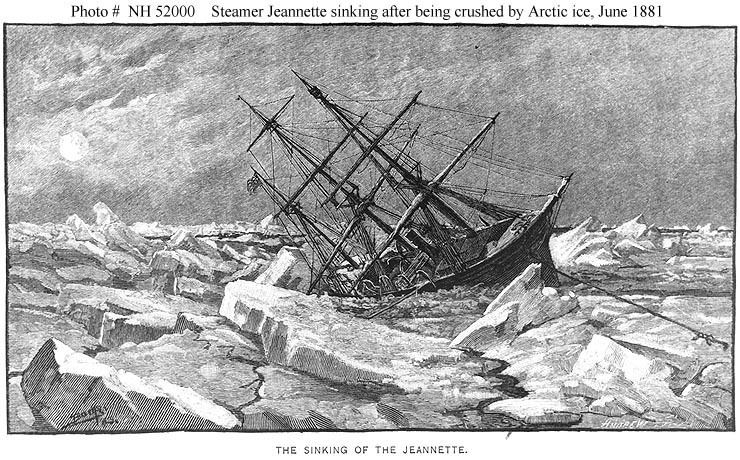Name HMS Pandora Laid down 30 March 1860 Construction started 30 March 1860 Length 43 m | Ordered 8 April 1859 Commissioned September 1861 Launched 1861 Beam 7.6 m | |
 | ||
Fate Sold to Sir Allen Young in 1875 | ||
USS Jeannette was a naval exploration vessel which in 1879–81, under the command of George W. De Long, undertook an ill-fated voyage to the Arctic. After being trapped in the ice and drifting for almost two years, the ship was released from its ice-grip, then trapped again, crushed and sunk some 300 nautical miles (560 km; 350 mi) north of the Siberian coast. De Long and most of his crew reached land, but many of them, including De Long, subsequently perished in the wastes of the Lena Delta.
Contents

The vessel had begun its active career in 1861 as HMS Pandora, a Royal Navy gunboat. After more than a decade's service off the West African coast and in the Mediterranean, Pandora was retired from duty and sold as a private yacht to a British explorer, Allen Young. Young took her on two voyages to the Arctic, in 1875 and 1876, before selling her to James Gordon Bennett, Jr., proprietor of The New York Herald, who changed its name to Jeannette. Although it sailed to the Arctic under the U.S. flag, subject to naval laws and discipline, Bennett remained responsible for the costs of the expedition.

In 2015 a Russian explorer and media celebrity announced that there were plans to raise Jeannette from the seabed, as a gesture of Russian-American friendship.

Construction and launch

The ship that became USS Jeannette began her life as a Royal Navy gunboat, built at the Pembroke Naval Dockyards in 1860. She was of wooden construction, 146 feet (45 m) in length and 25 feet (7.6 m) at the beam, with a draught of 25 feet (7.6 m). Her tonnage, calculated by Builder's Measure, was 428 tons, with a displacement of 570 tons. She was rigged as a barque, but her principal means of propulsion was by a steam-driven screw. Her armament was five guns. After her launch on 7 February 1861, Pandora was taken from Pembroke to Portsmouth Dockyard, where she was fitted with her engines and boilers, and underwent trials before commissioning. On October 22 she concluded her trials successfully, achieving a speed of 9.25 knots over a measured mile.
As HMS Pandora

In November 1861, during the American Civil War, the diplomatic incident known as the Trent affair caused the Admiralty to bring additional ships into active service. On 27 December 1861, Pandora was formally commissioned, as tender to HMS Majestic, and the following day sailed for Liverpool where Majestic was berthed. The crisis was quickly resolved; Pandora remained at Liverpool until January 1862 before returning to Portsmouth.

In April 1863 Pandora left Portsmouth for service off the coast of West Africa. She returned after four years, and was transferred to the reserve. In April 1868 she was recomissioned, and returned to West Africa. Two years later she was transferred to the Mediterranean squadron, based at Valletta, Malta. This was her last commission in British naval service. In July 1872, after two years in the Mediterranean she returned to Spithead, where she was taken out of active commission and berthed in Portsmouth as part of the steam reserve.
Allen Young
In 1875 Pandora was acquired from the navy by the yachtsman Allen Young, for use in one of the last expeditions sent to the Canadian Arctic to investigate the disappearance, thirty years previously, of the Franklin Expedition. Young sailed in June 1875, seeking not only for signs of Franklin but discover and complete the Northwest Passage, then unconquered. He was unsuccessful on both counts; he found no traces of Franklin, but was stopped by ice in Peel Sound, and returned to England. One of the financiers for this venture was James Gordon Bennett, Jr., the owner of The New York Herald. In 1876 Young took Pandora north again, for a second attempt on the Northwest Passage. He was diverted by a request from the Admiralty to look for the British Arctic Expedition under George Nares, which was engaged in an attempt to reach the North Pole from Smith Sound. The expedition did not require Pandora's assistance, and Young returned home. In 1877 Young sold Pandora to Bennett, who was planning his own Arctic expedition.
As USS Jeannette
Bennett's plan was to sail a vessel through the Bering Strait, on the theory that the warm Pacific Ocean current known as the Kuro Siwo would provide a "thermometric gateway" whereby a suitable ship might reach the North Pole. This was the primary objective, but the ship was also equipped for scientific observation. By agreement with the US Naval Department, Bennett would finance the expedition, but it would sail under naval laws and discipline, and would be commanded by a naval officer, George W. De Long. Pandora was renamed Jeannette, after Bennett's sister, and in January 1879 arrived at the Mare Island Naval Shipyard, to be fitted for Arctic service.
Jeannette departed San Francisco on July 8, 1879. She sent her last communication to Washington from St. Lawrence Bay, Siberia, on August 27. Shortly afterwards she encountered ice, of increasing severity as she pushed her way forward to Herald Island. On September 7 she was caught fast in the ice at 71°35′N 175°6′E. For the next 21 months, Jeannette drifted in an erratic fashion, generally to the northwest but frequently doubling back on herself. In May 1881, two islands were discovered, which De Long named Henrietta Island (after Bennett's mother) and Jeannette Island. On the night of June 12, when they had reached 77°15′N 154°59′E the pressure of the ice finally began to crush Jeannette. De Long and his men unloaded provisions and equipment onto the ice, and the ship sank the following morning.
The expedition began the long trek to the Siberian coast, hauling their sledges with boats and supplies. On their way they discovered a further island which they named Bennett Island in honor of the expedition's sponsor. After reaching the New Siberian Islands and gaining some food and rest, the party took to their three boats on September 12 for the last stage of their journey to the Lena Delta, their planned landfall. As a violent storm blew up, one of the boats (with Lt. Charles W. Chipp and seven men) capsized and sank. The other two craft, commanded by De Long and Chief Engineer George W. Melville with respectively 14 and 11 men, survived the severe weather but landed at widely separated points on the delta.
The party headed by De Long began the long march inland over the marshy, half-frozen delta to hoped-for native settlements. After much hardship, with many of his men severely weakened, De Long sent the two strongest, William F. C. Nindemann and Louis P. Noros, ahead for help; they eventually found a settlement and survived. DeLong and his 11 companions died of cold and starvation. In the meantime, on the other side of the delta, Melville and his party had found a native village and were rescued. Melville persuaded a group of locals to help him search for his commander. He succeeded in finding their landing place on the delta, and recovered De Long's logbook and other important records but returned without locating De Long group. In the following spring, Melville set out again, and found the bodies of De Long and his companions on March 23, 1882.
Aftermath
On June 18, 1884, wreckage from Jeannette was found on an ice floe near Julianehåb (now Qaqortoq), near the south-western corner of Greenland. This indicated that an ocean current flowed from east to west across the polar sea. It gave the Norwegian explorer Fridtjof Nansen the idea that a properly-constructed ship could enter the ice in the east, survive the pressure during the drift, and emerge in the Atlantic, perhaps having traversed the Pole itself. This theory was the basis of Nansen's Fram expedition of 1893–96.
In February 2015 the Russian adventurer, traveler and media personality Andrey Khoroshev announced that in consultation with the Russian Geographical Society, he was developing plans to locate and raise the wreck of the Jeannette. Khoroshev told The Siberian Times: "This vessel lies at a depth of only 18 metres (59 ft), with the known location down to 1,000 metres (3,300 ft). So in modern day conditions, to find and raise it is not such a hard task." He imagined that the event would be a great boost for Russia's relations with America, "which are not very good right now".
